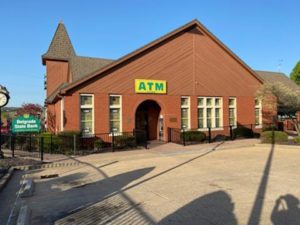
Looking at Belgrade State Bank’s Potosi, Mo., branch from the outside, you can likely guess right away the building was once a church. The converted branch still has a traditional steeple, arch-shaped entryways and original stained glass windows preserved from what used to be the Potosi Methodist Episcopal South Church.
Harold Turner, former president of Belgrade State Bank, bought the historic building in 1986 and converted it into the branch it is today — the third of five branches the bank operates throughout Eastern Missouri.
The building was in disrepair at the time, according to Julie Loughary, executive vice president, and Turner’s granddaughter. The church’s owners planned to tear it down; a local architect bought the structure but didn’t have the money to repair and restore it. That’s when Turner stepped in.
“My grandma asked my grandpa, ‘Are you sure you don’t want to tear this down?’” Loughary recalls. “Because it was quite a mess when it began.”
Today, you’d never know the building was once in shambles. The sanctuary area is now home to teller lines fit with cabinets and cages, old-school style. Look up, and you’ll notice the choir loft converted into office space. Look very closely and you might even notice that some of the paneling on the walls is made from wood from the church’s old pews.
Despite the dated appearance of the branch, Belgrade State Bank has adapted it to the modern day with an addition on the north side of the building, complete with drive-thru.

Loughary says that the bank’s historic appearance attracts local visitors and road-tripping tourists alike. The bank offers tours to school groups too.
“We get visitors quite a bit, especially in the summertime,” Loughary said. “You have historians, you have people who are longtime Methodists or churchgoers, or tourists just traveling through.”
Housing a bank in a historic building has its challenges, though. The Church’s cornerstone lists its original construction in 1901. Loughary says that the bank has dealt with everything from bats in the steeple to flooding in the underground cellar. In April 2020, someone drove their car into the side of the building when their brakes malfunctioned, causing damage. The bank had to scramble to find original building plans to figure out how to repair the damaged section and deal with an insurance agency reluctant to pay repair costs of such an old building.
“Upkeep on a new building is definitely a lot easier,” Loughary admitted. Despite the headaches that come with the building’s age, Loughary says its rich history in the Potosi community holds a special place in employees’ hearts.
“We have several people who work for us and they went to church there as a child,” she said. “So it’s pretty sentimental to them.”

The Potosi location isn’t the only branch with a unique offering. The bank’s Farmington, Mo., branch boasts a co-branded coffee shop in the lobby. Wise Grounds Coffee is a separate operation from the bank, with its own employees, but the shop helps with marketing and community outreach in Farmington, crafting gift baskets and offering gift cards to customers for bank initiatives.
“People really really like the coffee shop,” Loughary said. “Customers, they’re always asking, ‘Why won’t you have one in another location?’”
But Farmington is the largest commercial area in which the bank operates, making the coffee shop location a natural fit. “People can come in and they can sit down and visit [the bank],” Loughary said. “They can bring anyone in and you don’t have to be a customer.”
Both buildings serve not just as branches for people to conduct their business, but they are community attractions and local gathering spaces. That’s how Loughary sees it, and she hopes that others feel the same.
